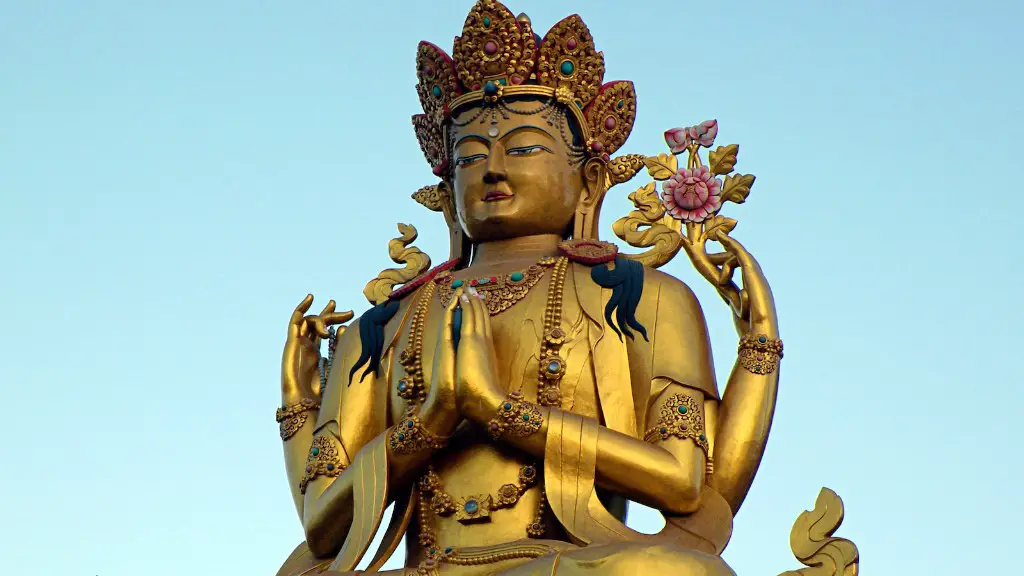Buddhism is a religion that was founded by Siddhartha Gautama in the 6th or 5th century BCE. It is based on the Four Noble Truths and the Eightfold Path. Buddhism spread throughout Asia, and eventually made its way to China. How Buddhism got to China is a bit of a mystery, but it is thought that it may have come to China through the Silk Road.
Buddhism first arrived in China during the Eastern Han Dynasty (25-220 CE) via the Silk Road from Central Asia. It is thought to have entered China through the city of Dunhuang in Gansu province. From there, it spread throughout the country, taking root in different regions and cultures.
Who brought the Buddhism to China?
Buddhism is a religion that was founded by Siddhartha Gautama, who is also known as the Buddha. It is an important religion in many countries in Asia. The main teachings of Buddhism are about suffering, the way to end suffering, and the path to enlightenment.
Buddhism was first introduced to China in the first century CE through overland and maritime routes from India and Central Asia. The Silk Road served as a major conduit for the spread of Buddhism to East Asia. The most important early Chinese Buddhist texts were translated into Chinese from Sanskrit and Central Asian languages. Buddhism quickly gained popularity in China and became an important part of Chinese culture.
When did Buddhism spread to China
Buddhism was introduced to China during the Han period and it had a significant impact on Chinese civilization. Mahayana Buddhism, the most prominent branch of Buddhism in China, played an important role in shaping Chinese culture.
The development of trade along the Silk Roads played a significant role in the expansion of Buddhism into eastern Asian lands, especially in Thailand and Indonesia. Excavations at Buddhist sites in these regions have revealed the interactions of these lands with Buddhist institutions linked to trading groups. These interactions suggest that the spread of Buddhism was facilitated by the movement of people and goods along the Silk Roads.
Why did the Chinese reject Buddhism?
Confucian intellectuals such as Han Yu railed against Buddhism for undermining the social structure of China. They claimed it eroded the loyalty of son to father, and subject to ruler, by encouraging people to leave their families and to become monks and nuns.
Buddhism flourished in ancient China because it was suited for both elites and lay people. Lay people were able to enjoy and relate to Buddhist doctrines, which made it attractive to a wide range of people.
How did Buddhism spread to China and Japan?
The history of Buddhism in Japan is a relatively short one when compared to the religion’s history in other parts of the world. Buddhism was officially transmitted to Japan in 525, when the monarch of the Korean kingdom of Baekje sent a mission to Japan with gifts, including an image of the Buddha, several ritual objects, and sacred texts. Buddhism’s journey from India to China, Korea, and Japan had taken about a thousand years.
Although the exact reason for why Buddhism was initially introduced to Japan is unclear, it is thought that the Baekje kingdom was attempting to establish diplomatic and trade relations with Japan. At the time, the Japanese islands were inhabited by a number of small, warring states, and Baekje may have seen an opportunity to gain an ally in the region.
Buddhism quickly took root in Japan and soon became the country’s dominant religion. It had a profound impact on Japanese culture, art, and architecture. Today, there are an estimated 12 million Buddhists in Japan.
Religious competition with other Indic religions and later Islam were also important factors in the decline of Buddhism in the northwest Indian subcontinent. With the invasions of the Huns in the 5th century, many Buddhist centres were destroyed and this led to a decline in Buddhism in the region.
Who brought Buddhism to Japan
Kobo Daishi is a well-known figure in the history of Buddhism in Japan. He is credited with bringing a new form of the religion, known as Shingon Buddhism, to the country about 1,200 years ago. This type of Buddhism stresses the importance of meditation and esoteric rituals in the path to enlightenment. Daishi was a highly influential figure in the development of Buddhism in Japan, and his teachings have had a lasting impact on the religion in the country.
The first century CE saw the expansion of Buddhism into new territories, including China. The Ming emperor invited the Buddhist bhikkhus Dharmarakshaka and Kashyapmatanga to China, where they proceeded to translated many Indian Buddhist texts into Chinese. This made the spread of Buddhism in China much easier and allowed for a greater understanding of the religion.
How did Buddhism spread so quickly?
Buddhism first originated in India, but quickly spread throughout Asia via trade routes and merchant ships. The Silk Road was a major trade route that connected China and the Middle East, and it was along this route that Buddhism first arrived in China. From there, it continued to spread throughout Southeast Asia. In each new region, Buddhism adapted to the local culture, resulting in the many different schools and traditions that exist today.
The main reason for the appeal of Gautam Buddha’s teachings is their simplicity and clarity. They are easy to understand and follow, and they address common concerns that people have. For example, the Four Noble Truths deal with the universal issue of suffering, and the Eightfold Path provides a clear and concise guide to living a moral and ethical life. In addition, Gautam Buddha was an extremely charismatic leader, and his message of tolerance and compassion resonated with many people.
How did Buddhism spread *
Buddhism was spread outside India through the efforts of missionaries, scholars, trade, emigration, and communication networks. Foreign monks who travelled along the silk route between India and China were responsible for the spread of Buddhism at sub-elite levels.
China has the largest population of Buddhists in the world, and they are mostly followers of Chinese schools of Mahayana Buddhism. This makes China the largest body of Buddhist traditions. Buddhism first came to China in the 1st century CE, and over the centuries it has been greatly influenced by Chinese culture. Today, Buddhists in China can be found in all walks of life, from the rural countryside to the urban cities.
Why do Buddhist not believe in god?
Buddhism is a tradition focused on spiritual liberation, but it is not a theistic religion. The Buddha himself rejected the idea of a creator god, and Buddhist philosophers have even argued that belief in an eternal god is nothing but a distraction for humans seeking enlightenment.
The constitution of the People’s Republic of China (PRC), which cites the leadership of the Chinese Communist Party (CCP), states that citizens “enjoy freedom of religious belief” but limits protections for religious practice to “normal religious activities,” without defining “normal” The government recognizes five religions: Buddhism, Taoism, Islam, Protestantism, and Catholicism. It requires religious groups to register with the state, and it prohibits unauthorized religious activity, which it defines as “any activity that uses an evil cult or superstition to undermine the implementation of the law and disrupt public order.”
Final Words
Buddhism is thought to have first come to China in the first century CE, though some scholars believe it may have arrived as early as the second century BCE. It is most commonly believed that Buddhism was brought to China by Indian missionaries, though there is some evidence that it may have come via Central Asia.
Buddhism was originally founded in India, but it quickly spread to other parts of Asia, including China. It is not exactly clear how Buddhism first arrived in China, but it is believed that it was either through trade or missionaries. Buddhism quickly became popular in China and played a significant role in the country’s history and culture.


